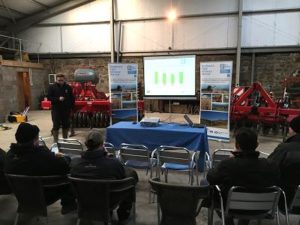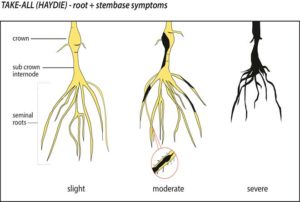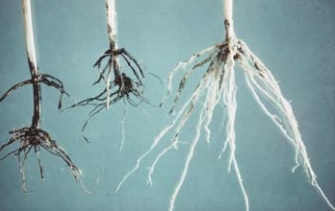Integrated Crop Management & New Tech (Lothians) – Event Summary
28 November 2017The principles of Integrated Crop Management, it’s importance and how it can be implemented was the focus of this recent meeting in Kirknewton. This is a summary of what was discussed at the event.
Alister Robertson, the host farmer, gave an introduction to the farm and the farming protocols. Bonnington is now solely an arable farm growing wheat rape and barley. Minimum tillage is employed to establish Oil seed rape and first wheats, with  everything else being established conventionally.
everything else being established conventionally.
Andy Evans delivered his presentation on controlling pests with a particular emphasis on pests of oilseed rape. Oil seed rape is a crop besieged by pests
- 2017 has been a bad year for slugs with wet weather at emergence giving ideal conditions for slugs. Metaldehyde slug pellets now have a 10m buffer no spread zone around any field edge, due to levels of Metaldehyde in water. You can still use ferric phosphate product around the edges and these are an effective control measure
- Cabbage stem flea beetle (CSFB) is a problem at crop emergence, the adult beetles can destroy the young plants as they emerge, they also breed and subsequently the larvae can cause problems. But the effects of larvae in Scotland are minimal compared to further south. It takes around 5 larvae to kill the oil seed rape and the most the audience had ever noted was 2 per plant
- Rape winter stem weevil is becoming more noticeable in Scotland , spreading northwards from Scottish Borders noted in Moray Firth in 2010 it lays eggs much later in October-November, Larvae burrow into stem and crown – production of lateral shoots, no stem elongation, lodging in spring. The adult weevils need to be targeted once the larvae burrow in they cannot be controlled.
Craig Bothwell delivered an update on the greening changes ahead of 2018. Key changes include;
- You are now longer allowed to apply pesticide to EFA N fixing crops
- No pesticide applied to EFA catch crops after the harvest of the nurse crop
- You can now cut or graze EFA field margins after the 15th of July. This makes using field margins for livestock farmers a lot easier. The field margin area still has to be maintained for the full year.
- Full details on the greening rules for 2018 are available at www.ruralpayments.org
Jonathan Black delivered a presentation on controlling take-all, take all is a disease which can cause yield losses of up to 20% & is characterised by black stubby roots in patches across the field.
- With warmer winters , wetter springs and loss of key seed treatments it would seem likely take all is going to become more of an issue on Scottish farms,
- rotational control is possible and is an effective way of controlling take all
- Limiting the use of second winter cereals on farm allows farmer to take advantage of Take all decline.
- Cultural control using cultivation equipment such as min till
You can read slides from Jonathan’s presentation here.
A short field walk was conducted with Agriis’ Greig Baird running through his key problems managing the rape crops this autumn;
- Establishment is key with Winter rape getting it in august so it has time to develop to survive the winter , but has to be done fast as many crops are being combined at this time of year
- at Bonnington they are using a subsolier to establish rape in a one pass system which is fast effective and the cost of establishment is low
- Rapid crop growth at establishment is a key cultural pest control method , if the crop grows quickly it can out grow damage from flea beetles and slugs
- We had set slugs traps in the field but due to the lower temperatures the slugs had moved down in the soil profile and stopped feeding. Slug damage could be seen where the previous crop of winter barley had lodged, this created a micro climate of warm damp soil in which the slugs could flourish
Soil specialist Bryan Griffiths talked about improving soil health and the practical steps farmers can take.
- analysing soil organic matter levels
- Worm counts and identifying different types of worms, some work in the top soil and others move up and down the soil profile.
- how to visually evaluate soil structure using the VESS (Visual Examination of Soil Structure) guide, identifying if your soil has a structural problem is the first step to correcting it.
Key points from the meeting
- This has been a tricky year to establish oil seed rape
- Establishment must be timely in order to take advantage of short weather windows
- Monitor slug populations from mid-summer to give time to react & put in place measures to reduce damage
- Take-all is likely to be more of an issue going forward & rotation is key for effective control
- A crop with a large number of break-crops is not necessarily a poor performing rotation
- Establish your crops when the soil conditions are right
Downloads related to the topics discussed at this meeting are available below.
Integrated Crop Management can help improve your overall productivity, which can benefit not only profitability but your farm business carbon footprint. For information on other changes you can make to your farm business to help reduce your carbon outputs, see Farming For a Better Climate.
- Pests Presentation, Andy Evans
- Update on Slugs, Leatherjackets, BYDV and Pollen beetles
- Valuing Your Soils – Practical Guidance for Scottish Farmers
- This brochure includes useful information about Scotland's agricultural soils and practical advice outlining the upfront financial savings and business benefits of better soil management and the efficient use of resources. Action and problem-specific 'field-sheets' are designed for busy farmers with limited time for reading.
- Topics: Climate Change, Soils, Water Management and Crops and Soils
- Sulphur for cereals and oilseed rape
Sign up to the FAS newsletter
Receive updates on news, events and publications from Scotland’s Farm Advisory Service


